MSI B85M ECO Review: Aiming Green at $73
by Ian Cutress on November 26, 2014 8:00 AM EST- Posted in
- Motherboards
- MSI
- B85
- ECO
MSI B85M ECO BIOS
If the Green Lantern (or perhaps Captain Planet) had a BIOS made especially for him, it would look something like the one MSI has equipped the B85M ECO with. If you have not had enough of the green theme, here it is in spades. The good thing for MSI is that the general BIOS layout is conducive to different color implementations, such as yellow for OC Certified and red for Gaming. Each of these gets a giant central logo, and here we get the ECO series version with a leaf being cupped by two hands.
Along the top ribbon is our usual fare of MSI data: Motherboard name, BIOS version, CPU installed, CPU speed, DRAM frequency, DRAM size, temperatures and boot order. As this is a B85 motherboard, the only real data missing here is perhaps the CPU fan speed, in case a dumb user (like I did) forgot to plug a CPU fan in at first.
On the top left is our ECO button which mimics the physical button on the motherboard as well as the ECO setting in software. This is where we normally see the XMP button on the main consumer line of motherboards.
In our six tabs we get two changes from normal – OC options become ECO and the OC Profiles become ECO Profiles. While the latter stays the same (saving the BIOS state to reload later), the ECO options gets the bulk of the BIOS changes.
However the first tab is the Settings options and anyone familiar with MSI BIOSes will not find anything out of place here. The first menu item, System Status, gives details on the BIOS and SATA ports connected:
The Advanced option in the Settings tab is more of the meaty part of the BIOS, giving configuration options for almost all of the onboard controllers.
There is not much here out of the ordinary. This motherboard supports Hot Plug on the SATA ports, although it is disabled via the Integrated Peripherals menu by default in order to speed up POST time and reduce power consumption when not in use.
Rapid Start is disabled by default, but Smart Connect is enabled as some of MSI’s OS software uses it incase the user wants to use it. The BIOS also includes Windows 8/8.1 fast booting features as well as Secure Boot and Wake Up events.
Users wanting to shave some more time from the POST, if they have full UEFI enabled hardware, can disable legacy boot options from the boot menu. Options such as Boot Override are found in the Save and Exit menu.
The real interesting new stuff in the BIOS comes in the ECO tab, where the first options allow the user to determine how the ECO button is controlled and if XMP should be enabled. As a side note, while we get XMP options, there are no sub-timing menus should users wish to optimize their memory manually.
In the Cut Power menu option we are able to disable various LEDs and fan headers from system POST. This is a cut down version of the options we get in the OS, but it is interesting to consider that MSI does not allow users to undervolt their CPU. As a system that is focused on saving power, for those users that know what they are doing, undervolting into a more efficient power band might save even more power. We asked MSI about this, and have published the response in the conclusion.
The ECO tab also gives details on CPU functionality and tech, although users might want to migrate to the CPU Features option to organize their power limits or C-states.
The M-Flash tab allows users to update the BIOS via a USB stick, and the ECO Profiles tab as mentioned above lets the user to save the BIOS for a future time or to share with others. I find this a bit odd – no user is going to dabble with profiles saving a few hundred milliwatts here and there depending on their usage that day, let alone share it with friends.
MSI’s interactive hardware monitor / fan controls are here. These appeared a little while ago now and even though there is not complete fine grain control over the settings, it does give an opportunity for MSI to show exactly what a BIOS can do when you focus more on user experience than pure functionality.
To finish up, we also get Board Explorer to help diagnose POST issues. The B85M ECO also has a favorites menu although the usage of such a menu in this type of product is not something I predict many (if any) users taking advantage of.


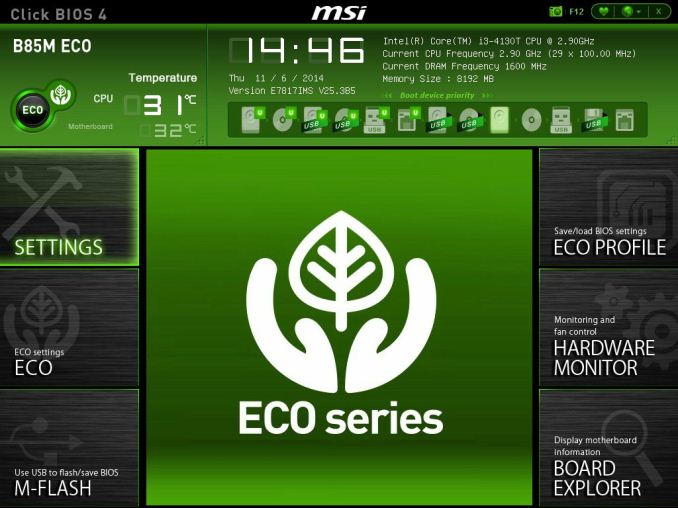
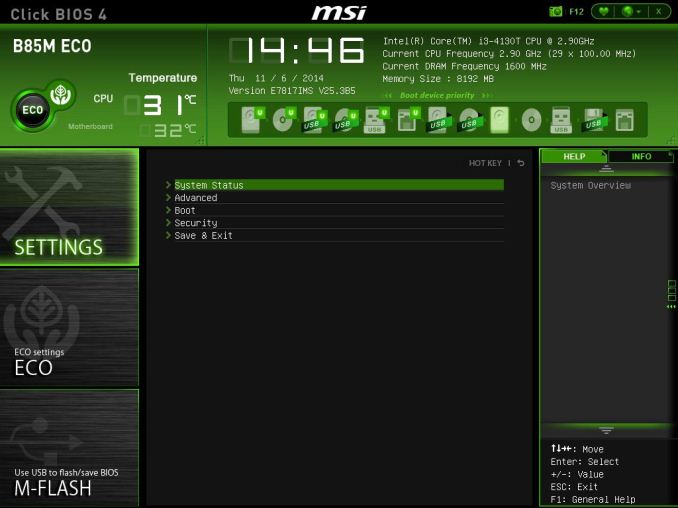
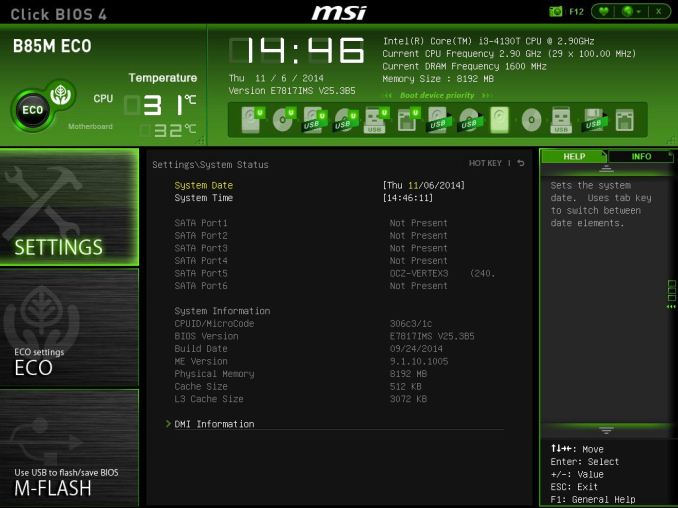

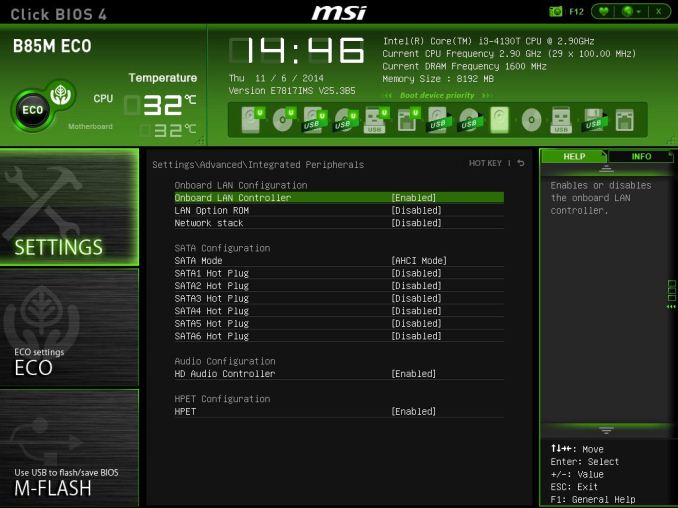

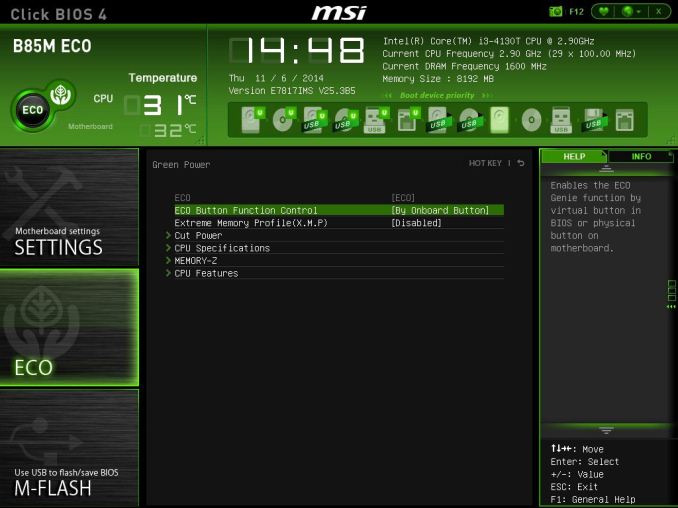
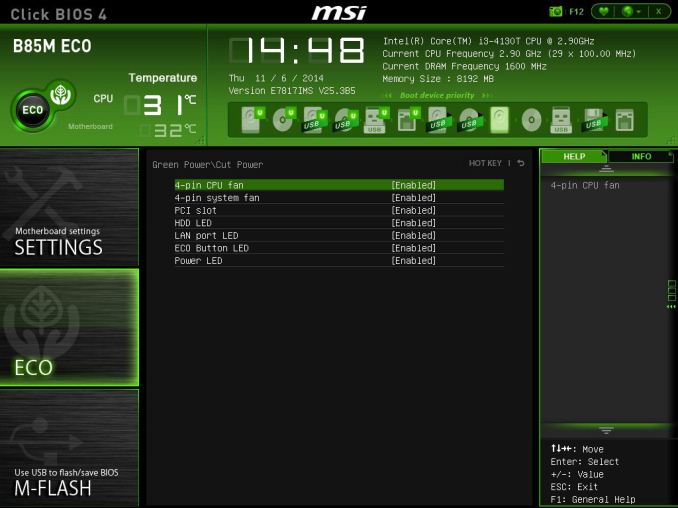
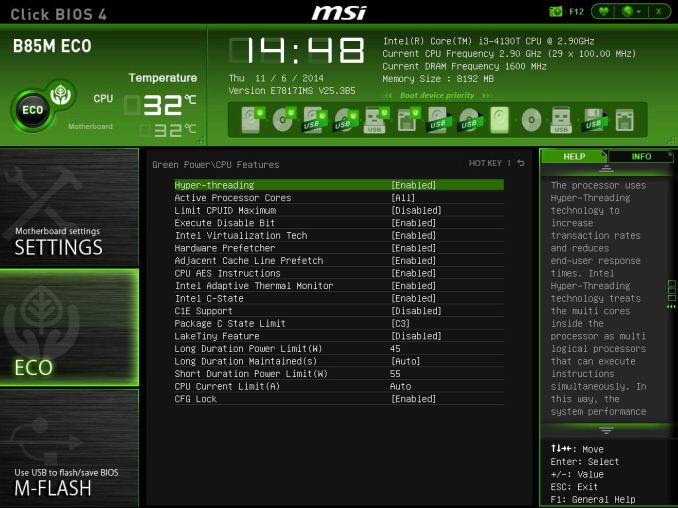
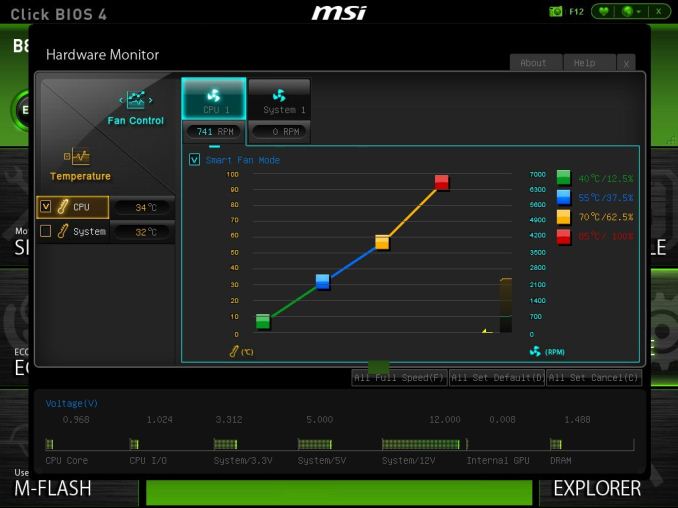















40 Comments
View All Comments
Cygni - Wednesday, November 26, 2014 - link
A Mini-ITX ECO would be right in my wheelhouse.I have an HTPC/NAS/Steam Mini-ITX thats on 24/7 and is several years old. It's next replacement cycle would likely last 5+ years, and the lowered power draw (plus lower heat) would be a no brainer over that lifetime. Could also see a market for personal servers and the like in Mini-ITX.
I would echo the request for undervolting access, even if its rarely worth it. The option would be appreciated to tinker with, if nothing else.
PaulJeff - Wednesday, November 26, 2014 - link
I think the point of these "eco" boards is determined by the economy of scale. For a real world example, you would need to replace dozens if not hundreds of workstations/desktops in an office to realize the true savings potential. If one workstations nets a few dollars a year in savings on power costs, multiply that by the number of workstations that will be replaced, multiply that by the # of years between hardware refresh cycles and that will add up the potential power savings.MSI should be selling this "ECO" brand to OEMs like Dell, HP, etc. and then the savings can be distributed on a mass market scale.
The cost delta between a non-ECO branded board and an ECO board is not worth it for SMB's and home users.
ultimatexbmc.com - Wednesday, November 26, 2014 - link
Good priceDaiz - Wednesday, November 26, 2014 - link
The price of electricity does not take into account the true cost of it's generation.It might be good to also consider the amount of fuel that is required or carbon output
for example 1kWh of electricity requires ~0.5kg of coal and produces ?? kg of carbon dioxide.
so assuming a 5 year upgrade cycle is going to happen no matter what, you are still stopping ~27.5kg of coal from being burned each year or 137.5kg over the life of the mobo. multiple by the number of machines in an office and every little bit helps.
Conficio - Wednesday, November 26, 2014 - link
Should the energy savings and cost savings not also include the cost for air conditioning/cooling? I know that server rooms care about that. So there should be at least some back of the envelope numbers which should increase the amount of savings somewhat.I'm just curious.
Lerianis - Thursday, November 27, 2014 - link
One thing I wanted to point out: 300 Watt power supply? Eh eh...... even a bargain basement, non-gaming intended dicrete graphics card needs 400 Watts minimum, unless it is the REALLY cheap ones sold to HP/Dell/Gateway for their office PC's.A regular person cannot even order one of those unless they go online and 'lie' to the HP parts person telling them "Yeah, my video card died and I want to replace it myself, can I order one of your replacement discrete graphics cards?"
400 Watts is a more realistic minimum for a system with a discrete graphics card, though with the new integrated graphics from Intel being able to push HD 1080p and 1920*1080 resolution other content without a stutter while using less than 2% of the CPU's power on an i5..... they might have an argument that no one needs a discrete graphics card who is not an uber-gamer anymore.
KAlmquist - Friday, November 28, 2014 - link
Actually, a 300 watt power supply should be enough to power a single GTX 980. However, Ian was presumably thinking about the standard business PC, which uses integrated graphics these days. As you correctly note in your last paragraph, the primary market for discrete graphics cards is now gamers.jtd871 - Thursday, December 4, 2014 - link
Ian,Thanks for reviewing a non-flagship board. Like others who have commented here, I could see something like this finding a home in a future personal build for productivity, light engineering and moderate gaming. And it's $25 to $50 less than the Z-series boards. Please, more like this in the uATX and mITX form factors!
Some feedback for MSI (and other board OEMs): ditch the (non-express) PCI already, please? Any business willing to buy enough of these isn't going to stick PCI add-in boards inside (assuming they can still find drivers for use with their modern operating systems). I would suggest eliminating the PCI slot altogether and keeping the x16 slot separated from the other 2 PCIe slots, as a lot of even low-end GPU cards (for business multi-monitor, say) are at least a double-slot width - rendering the 2nd slot unusable in those situations anyway, and make at least 1 of the remaining slots at least physically x8.
azazel1024 - Thursday, December 11, 2014 - link
This seems like a really stupid test of the power efficiency since that is the main focus. A REAL PSU, like a bronze or higher rated PSU in the 350-500w range should have been used. Either a standard B85, or H85/7 or something should have been compared to it. you have a board with an over abundance of features versus one bereft.Otherwise it is apples to oranges.
Also, if MSI's claims are accurate, the ECO frankly sucks. My Sever with a G1610 in it, H67, 8GB (2x4GB) G.Skill Sniper@1.2v, SSD, 2 HDDs plugged in and a pair of Intel Gigabit CT NICs and Antec Earth Watts 380 burned 21w at idle, drives spun down. The ENTIRE system uses less than what MSI claims a typical uATX boards uses at idle. Based on Intel's numbers for some things like the NICs, I have to assume that the board is using at MOST 15w and probably closer to 12w.
Seems like at most we are talking 2-3w of power savings MAYBE comapred to a VAGUELY similar board.
know of fence - Monday, March 2, 2015 - link
Being an enthusiast site AT always played down power consumption numbers. But just making assumptions and low balling 4 different variables (price, hours, efficiency, years of operation) is both cumbersome and somewhat disingenuous.A more elegant way would be to create a realistic range for those variables and combine them into coefficients for min, max and typical scenarios. You could even do typical US, typical EU, UK, India or whatever.
For me every 1 W saved 24/7 equals 2 EUR/annum, also 66 cent per Watt per year assuming 8 hours a day operation. Not to mention that PCs actually last anywhere from 5 to 10 years, though they are much less frequently used, once they are handed down to relatives.